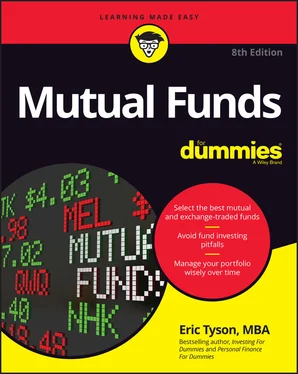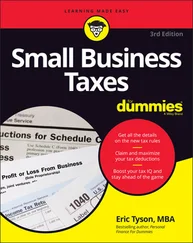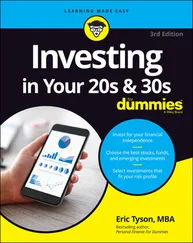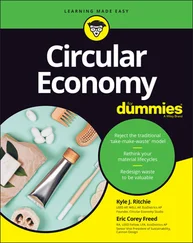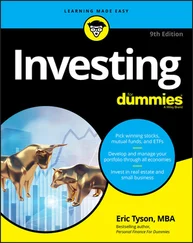Eric Tyson - Mutual Funds For Dummies
Здесь есть возможность читать онлайн «Eric Tyson - Mutual Funds For Dummies» — ознакомительный отрывок электронной книги совершенно бесплатно, а после прочтения отрывка купить полную версию. В некоторых случаях можно слушать аудио, скачать через торрент в формате fb2 и присутствует краткое содержание. Жанр: unrecognised, на английском языке. Описание произведения, (предисловие) а так же отзывы посетителей доступны на портале библиотеки ЛибКат.
- Название:Mutual Funds For Dummies
- Автор:
- Жанр:
- Год:неизвестен
- ISBN:нет данных
- Рейтинг книги:3 / 5. Голосов: 1
-
Избранное:Добавить в избранное
- Отзывы:
-
Ваша оценка:
- 60
- 1
- 2
- 3
- 4
- 5
Mutual Funds For Dummies: краткое содержание, описание и аннотация
Предлагаем к чтению аннотацию, описание, краткое содержание или предисловие (зависит от того, что написал сам автор книги «Mutual Funds For Dummies»). Если вы не нашли необходимую информацию о книге — напишите в комментариях, мы постараемся отыскать её.
Mutual Funds For Dummies
Mutual Funds For Dummies
Mutual Funds For Dummies — читать онлайн ознакомительный отрывок
Ниже представлен текст книги, разбитый по страницам. Система сохранения места последней прочитанной страницы, позволяет с удобством читать онлайн бесплатно книгу «Mutual Funds For Dummies», без необходимости каждый раз заново искать на чём Вы остановились. Поставьте закладку, и сможете в любой момент перейти на страницу, на которой закончили чтение.
Интервал:
Закладка:
As you understand more about this process, notice that the time horizon of your goal — in other words, how much time you have between now and when you need the money — largely determines what kind of fund is appropriate:
If you need to tap in to the money within two or three years or less, a money market or short-term bond fund may fill the bill.
If your time horizon falls between three and seven years, you want to focus on bond funds.
For long-term goals, seven or more years down the road, stock funds are probably your main ticket.
But time horizon isn’t the only issue. Your tax bracket, for example, is another important consideration in fund selection. (See Chapter 10for more about taxes.) Other variables are goal specific, so take a closer look at the goals themselves.
The financial pillow — an emergency reserve
 Before you save money toward goals, accumulate an amount of money equal to about three to six months of your household’s living expenses. This fund isn’t for keeping up on the latest consumer technology gadgets. It’s for emergency purposes: for your living expenses when you’re between jobs, for unexpected medical bills, for a last-minute plane ticket to visit an ailing relative. Basically, it’s a fund to cushion your fall when life unexpectedly trips you up. Call it your pillow fund. You’ll be amazed how much of a stress reducer a pillow fund is.
Before you save money toward goals, accumulate an amount of money equal to about three to six months of your household’s living expenses. This fund isn’t for keeping up on the latest consumer technology gadgets. It’s for emergency purposes: for your living expenses when you’re between jobs, for unexpected medical bills, for a last-minute plane ticket to visit an ailing relative. Basically, it’s a fund to cushion your fall when life unexpectedly trips you up. Call it your pillow fund. You’ll be amazed how much of a stress reducer a pillow fund is.
How much you save in this fund and how quickly you build it up depends on the stability of your income and the depth of your family support. If your job is steady and your folks are still there for you, then you can keep the size of this fund on the smaller side. On the other hand, if your income is erratic and you have no ties to benevolent family members, you may want to consider building up this fund to a year’s worth of expenses.
The ideal savings vehicle for your emergency reserve fund is a money market fund. See Chapter 11for an in-depth discussion of money market funds and a list of the best ones to choose from.
LOOKING AT HIGH-RISK FUNDS
The goals discussed in this chapter — creating and maintaining an emergency fund, retirement, buying a home, higher education funding, and so on — are traditional and common goals that many folks have. Of course, you may have some other dreams and aspirations. And those need not be that specific. For example, maybe you’d like to take some greater risk with some of your money because “you only live once” (also known as YOLO). I observe that line of thinking with a number of young adults.
As a constant observer of the mass media, the YOLO crowd has plenty of interests including such vehicles as meme stocks, options trading, cryptocurrencies, NFTs, cannabis stocks, and more. What all of these have in common is that you won’t find any recommended funds in this book that specialize in these either because they’re way too risky and/or disallowed by the Securities & Exchange Commission in mutual funds. As a better long-term alternative, I encourage you to find out about the higher-risk stock funds discussed in this book.
I strongly recommend that you limit such high-risk investments to a small or modest portion of your portfolio, such as 5 to 10 percent. Also, be honest with yourself about the risks you are taking and the possibility with really-high-risk investments of losing your entire investment. People are lured into such investments by dreaming about the potential profits if they are right, but they often fail to realistically consider the downside if they are wrong. Last but not least: You should never ever put money that you might need for an emergency (such as losing your job, suffering medical problems, being hit with unexpected home or auto repairs, or having a family emergency) in these high-risk investments.
The golden egg — investing for retirement
Uncle Sam gives major tax breaks for retirement account contributions. This deal is one you can’t afford to pass up. The mistake that many people at all income levels make with retirement accounts is not taking advantage of them and delaying the age at which they start to sock money away. The sooner you start to save, the more confident you can be in having enough to retire comfortably, because your contributions have more years to compound.
Each decade you delay approximately doubles the percentage of your earnings that you should save to meet your goals. For example, if saving 5 percent per year starting in your early 20s would get you to your retirement goal, waiting until your 30s may mean socking away 10 percent; waiting until your 40s, 20 percent; beyond that, the numbers get troubling.
 Taking advantage of saving and investing in tax-favored retirement accounts should be your number-one financial priority (unless you’re still paying off high-interest consumer debt on credit cards or an auto loan).
Taking advantage of saving and investing in tax-favored retirement accounts should be your number-one financial priority (unless you’re still paying off high-interest consumer debt on credit cards or an auto loan).
Retirement accounts should be called tax-reduction accounts. If they were called that, people might be more excited about contributing to them. For many people, avoiding higher taxes is the motivating force that opens the account and starts the contributions. Suppose you’re paying about 35 percent between federal and state income taxes on your last dollars of income (see Chapter 10to determine your tax bracket). For most of the retirement accounts described in this chapter, for every $1,000 you contribute, you save yourself about $350 in taxes in the year that you make the contribution. That means you have $1000 in your retirement savings and $350 in your pocket that didn’t go to federal and state income taxes versus just $650 left for you after taxes if you don’t contribute. You can invest all of this savings until it’s taxed when withdrawn in retirement. Some employers will match a portion of your contributions to company-sponsored plans, such as 401(k) plans — getting you extra dollars for free.
On average, most people need about 70 to 80 percent of their annual preretirement income throughout retirement to maintain their standard of living. If you haven’t recently thought about what your retirement goals are, looked into what you can expect from Social Security (okay, cease the giggling), or calculated how much you should be saving for retirement, now’s the time to do it. My book Personal Finance For Dummies (Wiley) goes through all the necessary details and explains how to come up with more money to invest.
When you earn employment income (or receive alimony), you have the option of putting money away in a retirement account that compounds without taxation until you withdraw the money. With many retirement accounts, you can elect to use mutual funds as your retirement account investment option. And if you have retirement money in some other investment option, you may be able to transfer it into a fund company (see Chapter 16).
 If you have access to more than one type of retirement account, prioritize which accounts to use by what they give you in return. Your first contributions should be to employer-based plans that match your contributions. After that, contribute to any other employer or self-employed plans that allow tax-deductible contributions. If you’ve contributed the maximum possible to tax-deductible plans or don’t have access to such plans, contribute to an IRA. The following sections include the major types of accounts and explain how to determine whether you’re eligible for them.
If you have access to more than one type of retirement account, prioritize which accounts to use by what they give you in return. Your first contributions should be to employer-based plans that match your contributions. After that, contribute to any other employer or self-employed plans that allow tax-deductible contributions. If you’ve contributed the maximum possible to tax-deductible plans or don’t have access to such plans, contribute to an IRA. The following sections include the major types of accounts and explain how to determine whether you’re eligible for them.
Интервал:
Закладка:
Похожие книги на «Mutual Funds For Dummies»
Представляем Вашему вниманию похожие книги на «Mutual Funds For Dummies» списком для выбора. Мы отобрали схожую по названию и смыслу литературу в надежде предоставить читателям больше вариантов отыскать новые, интересные, ещё непрочитанные произведения.
Обсуждение, отзывы о книге «Mutual Funds For Dummies» и просто собственные мнения читателей. Оставьте ваши комментарии, напишите, что Вы думаете о произведении, его смысле или главных героях. Укажите что конкретно понравилось, а что нет, и почему Вы так считаете.
